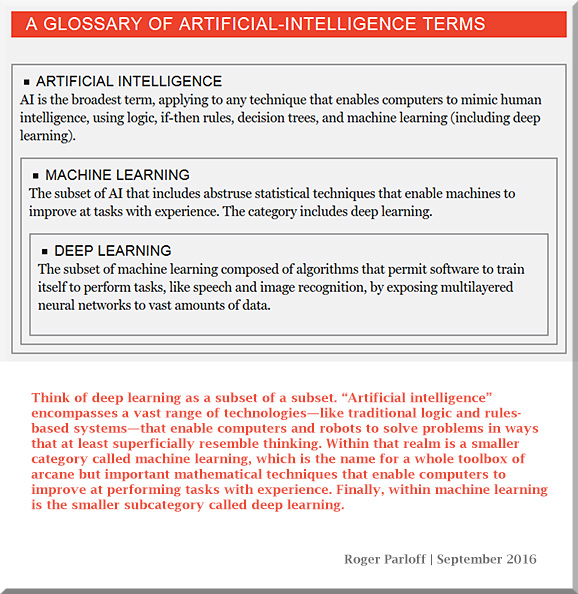Why deep learning is suddenly changing your life — from fortune.com by Roger Parloff
Excerpt:
Most obviously, the speech-recognition functions on our smartphones work much better than they used to. When we use a voice command to call our spouses, we reach them now. We aren’t connected to Amtrak or an angry ex.
In fact, we are increasingly interacting with our computers by just talking to them, whether it’s Amazon’s Alexa, Apple’s Siri, Microsoft’s Cortana, or the many voice-responsive features of Google. Chinese search giant Baidu says customers have tripled their use of its speech interfaces in the past 18 months.
Machine translation and other forms of language processing have also become far more convincing, with Google, Microsoft, Facebook, and Baidu unveiling new tricks every month. Google Translate now renders spoken sentences in one language into spoken sentences in another for 32 pairs of languages, while offering text translations for 103 tongues, including Cebuano, Igbo, and Zulu. Google’s Inbox app offers three ready-made replies for many incoming emails.
…
But what most people don’t realize is that all these breakthroughs are, in essence, the same breakthrough. They’ve all been made possible by a family of artificial intelligence (AI) techniques popularly known as deep learning, though most scientists still prefer to call them by their original academic designation: deep neural networks.
Even the Internet metaphor doesn’t do justice to what AI with deep learning will mean, in Ng’s view. “AI is the new electricity,” he says. “Just as 100 years ago electricity transformed industry after industry, AI will now do the same.”
Graphically speaking:
“Our sales teams are using neural nets to recommend which prospects to contact next or what kinds of product offerings to recommend.”
One way to think of what deep learning does is as “A to B mappings,” says Baidu’s Ng. “You can input an audio clip and output the transcript. That’s speech recognition.” As long as you have data to train the software, the possibilities are endless, he maintains. “You can input email, and the output could be: Is this spam or not?” Input loan applications, he says, and the output might be the likelihood a customer will repay it. Input usage patterns on a fleet of cars, and the output could advise where to send a car next.











